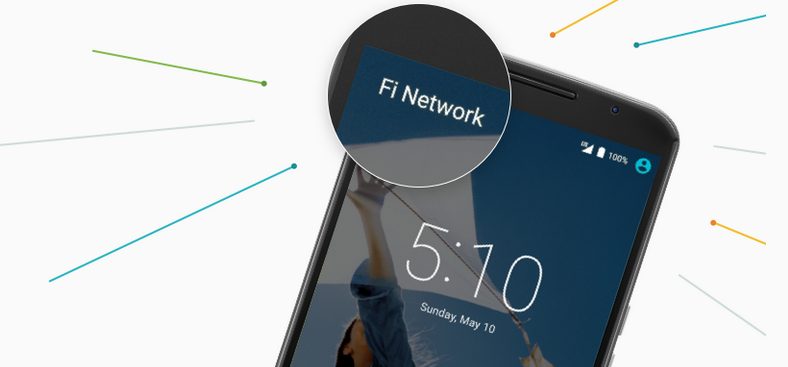
Nothing.
At least at first.
Earlier today, Google revealed Project Fi, a provider of wireless service that tries to commoditize the idea of choosing a network by dynamically doing so for you. Partnering with T-Mobile and Sprint, the laundry list of prerequisites belies a project that can only be criticized for its newness.
First, the specifics: the service, which is in testing and being rolled out on an invite-only basis, requires a new SIM card and works on just one device, the Nexus 6. Doing so gives Google control over the entire stack, from the hardware to the software (which it creates) to the network. It’s really smart. Google will dynamically switch between T-Mobile’s and Sprint’s respective 3G and LTE networks depending on signal quality in a given area; neither Sprint nor T-Mobile are known for their great rural coverage, so signing deals with two carriers was likely a base requirement for getting Fi up and running.
The third head of Google’s hydra is really the biggest toss-up; the company plans to leverage a constantly-updating database of free and high-quality WiFi networks around the United States to seamlessly hand off traffic. Even calls can be made over WiFi, as the company is using its Google Voice backend to make and receive phone calls, virtually, from a single number. In practice, this means being able to receive phone calls on devices other than the one registered to Fi, since Google Voice intercepts incoming calls and redirects them to any registered device.
In order to protect users on these open WiFi networks, Google plans to use a VPN to encrypt and anonymize user traffic.
Perhaps more interesting than the service is the way Google has set up its plan tiers. Every Fi user pays $20 per month for unlimited nationwide calling, texting, voicemail and call display, very similar to the $40-$60 base Canadians pay for the same privilege. Then, data is tacked on at $10 per gigabyte. Unused data is credited towards the next month’s bill, so if a Fi customer uses only 500MB of his 1GB plan, $5 will be credited towards the next bill. And because Fi is a prepaid-only service, that credit won’t just sit there unused.
Fi also takes advantage of T-Mobile’s free international data roaming deal, which includes data. Speeds are limited to 256kbps/128kbps, but it’s better than nothing (and yes, Canada is included).
So how will this affect Canada – and could Project Fi move north? Technically yes, according to telecom analyst Ben Klass. “The law was changed in 2012 to allow foreign ownership of start-up carriers, so legally Google could operate here,” he told me.
But the likelihood of it happening is almost zero, especially given the response from the Big Three to Verizon’s prospective migration in 2013. “The carriers here are very hostile to MVNOs, so it is unlikely that Google would set up shop without some sort of regulatory intervention.”
At this point, though, Project Fi shouldn’t be seen as anything more than an experiment on Google’s part. “Scale is important in the early stages,” said Kaan Yigit, a telecom analyst at Solutions Research Group. “If they can get traction in a big market like the US, I can see a roll-out of sorts [down the line].”
He said that T-Mobile and Sprint were likely looking for additional partners, and a big name like Google gives their burgeoning networks a huge marketing boost. “Sprint and T-Mobile are underdelivering [compared to AT&T and Verizon], so they would be open to this,” he noted. “In Canada, I don’t see the Big Three wanting to cut a deal with a reseller.”
Compared to the United States, Canada barely has a market for MVNOs (mobile virtual network operator), which rely on the bulk purchase of airtime and data from larger networks. Until recently, Canadian carriers could charge MVNOs and smaller carrier whatever they wanted for data, but a CRTC decision lowered that to the same price they charge their own customers. Wind and Videotron have said publicly that they are waiting on the CRTC to further regulate domestic roaming charges before earnestly expanding their networks nationally. In an interview earlier this year, former Wind Mobile chairman Anthony Lacavera told me that for a long time he likened the spectrum situation for new entrants to “an opportunity to fight over table scraps.”
Now that Wind and Videotron each own a fair amount of AWS-3 and, potentially, 2500Mhz spectrum (and in the case of Videotron, 700Mhz), things are looking better for the smaller Canadian carriers, but the possibility of Google entering the market is highly unlikely.
“So what does Google wireless mean for Canada?” Klass asked, both himself and the universe. “That we’ll get to look south with envy once again, while the three national carriers continue to dominate the market here with over 90% market share.”
MobileSyrup may earn a commission from purchases made via our links, which helps fund the journalism we provide free on our website. These links do not influence our editorial content. Support us here.


